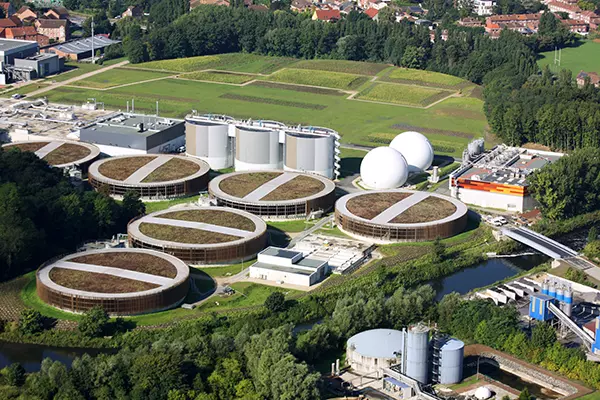What is AnoxKaldnes Hybas™?
Hybas™ is a solution for nitrogen removal based on Integrated Fixed Film Activated sludge (IFAS) technology, where the best properties of MBBR and Activated Sludge (AS) are merged into one compact, energy-efficient system.
You’ll find the answers to common questions about Hybas™ and why you should choose it below.

Is Hybas™ new?
No, it’s a continually updated and improved system based on MBBR technology, originally developed by AnoxKaldnes in the 80s and 90s.
The first full-scale Hybas™ came into operation in 2002 at Broomfield, Colorado, US, (see picture below) followed by Klippan WWTP, Sweden, in 2003.

|
What does HYBAS stand for?
Hybrid Biofilm Activated Sludge
How many references exist?
AnoxKaldnes has delivered 70+ full-scale installations out of approximately 200 full-scale plants with IFAS technology worldwide since 2002.
How big are Hybas™ plants?
Sizes vary from approximately 10,000 pe up to 620,000 pe at Lille Marquette in Paris, in operation since 2013.

Is Hybas™ only used for upgrades in existing volumes?
Hybas™ is a competitive choice for Greenfield plants when the footprint is limited. Hybas™ was chosen for the Lille Marquette plant (620,000 pe) in Paris as a greenfield solution in comparison to other compact technologies. MBBR is a good choice for increasing nitrogen removal capacity in existing volumes. The same is true for Hybas™.
What carriers can be used in Hybas™?
A wide variety of carriers are used. The most cost-efficient carriers, in most cases, are the AnoxK™5 carrier and the AnoxK™Chip M carrier.
Can carriers be clogged due to the suspended biomass?
Actually the opposite. Clogging can occasionally occur in pure MBBRs where the nitrification stage is overloaded with BOD (above design load). In a Hybas™, all biodegradable BOD will be absorbed into the suspended biomass, protecting the nitrifying biofilm and keeping it in an optimal range.
How does an upgrade impact my operation?
You minimize the impact of an upgrade if it is performed within existing volumes. The best choice is to upgrade one train at a time, preferably during summer when the remaining trains can sustain removal requirements. AnoxKaldnes also provides a solution, where suitable, for a side-stream treatment line with the advantage of reducing downtime.
How does Hybas™ impact downstream settleability (SVI)?
Hybas™ is often applied on plants near reaching their capacity meaning they are pushing the limits on sludge age and good settleability. Hybas™ has been proven to greatly improve settleability.
Can you obtain enhanced phosphorus removal in Hybas™?
Hybas™ is a chemical-free solution for phosphorus removal. You can apply all different types of Enhanced Biological Phosphorus Removal (EBPR) in AS-systems in a Hybas™. Since P-removal in EBPR takes place through wasting of P-rich sludge and the sludge age is shorter in Hybas™, less P content needs to be met compared to an AS with longer sludge age for the same daily P removal. A higher P-release and P-uptake are obtained by the highly active suspended biomass in the Hybas™.
Can micropollutants be removed in a Hybas™?
Early studies have shown that biofilm systems can better remove some of the compounds that activated sludge systems were not able to tackle. By combining activated sludge and biofilm in Hybas™, you can expect an improved removal of approximately 20% (varying for specific compounds). Combining Hybas™ with post-treatment for further micropollutant removal can decrease operating costs downstream compared to treatment after activated sludge only.
Is N₂O produced in Hybas™?
A study that was part of a Danish research project (LaGas funded by the Danish Council for Strategic Research) showed significantly lower N₂O production in a Hybas™ train (0.04% of nitrogen loading) compared to a reference train with only AS (0.95% of the nitrogen loading). Potentially, higher dissolved oxygen in the Hybas™ stage with carriers offers a degree of prevention for N₂O production.
Can Hybas™ be used for Industrial applications?
The short answer is yes. AnoxKaldnes continuously evaluates the best possible solution for all projects based on the wastewater and the client's specific needs. Hybas™ has been installed for industrial applications.
Common Industrial applications:
Are you interested in knowing more about AnoxKaldnes Hybas™?
Contact your AnoxKaldnes sales representative to find out more about this technology


